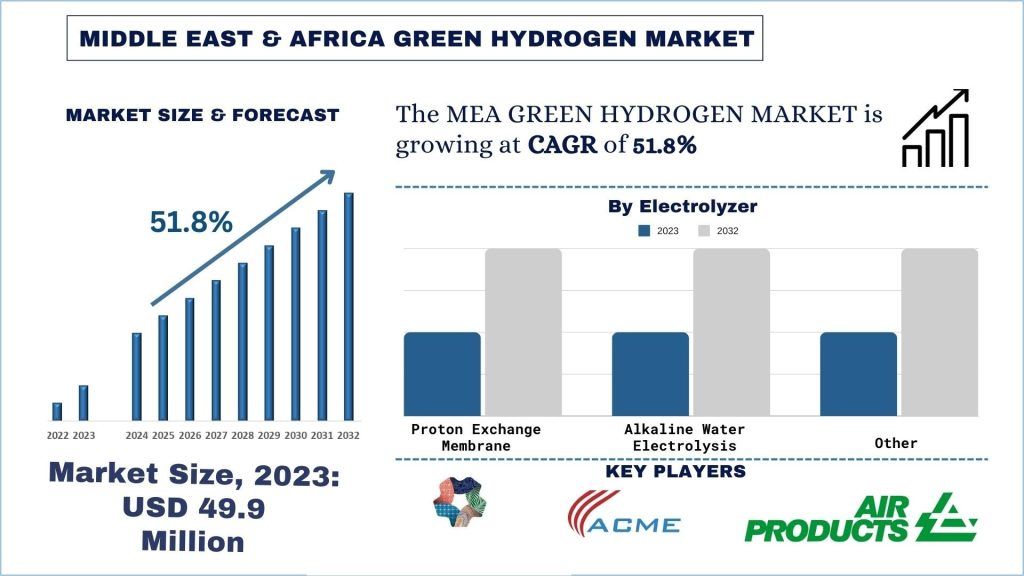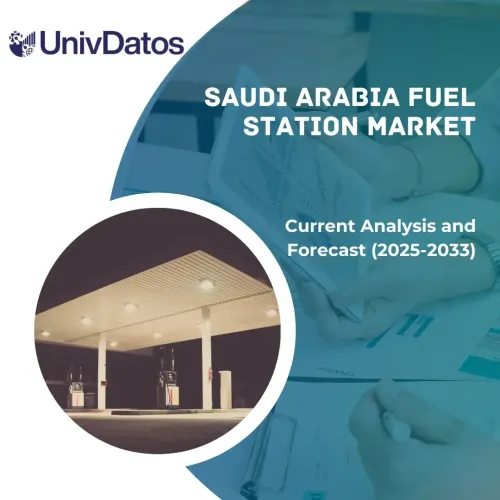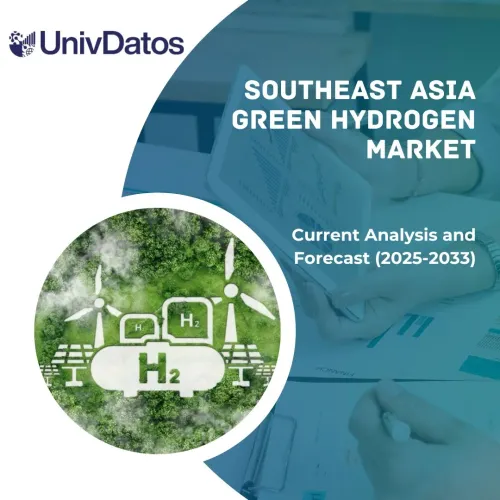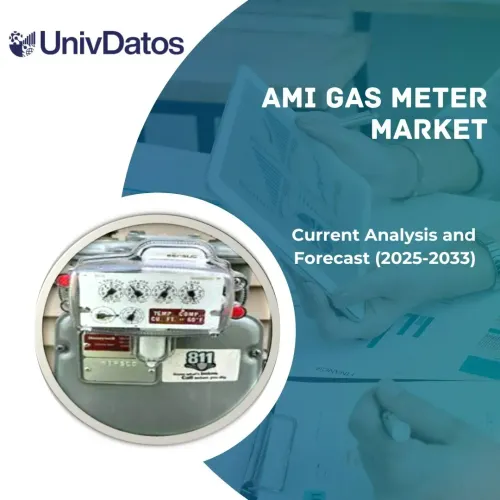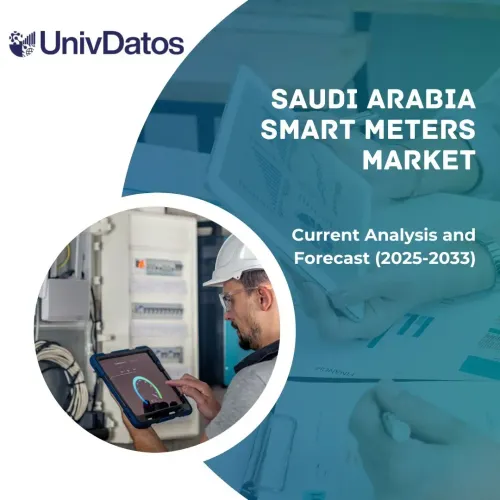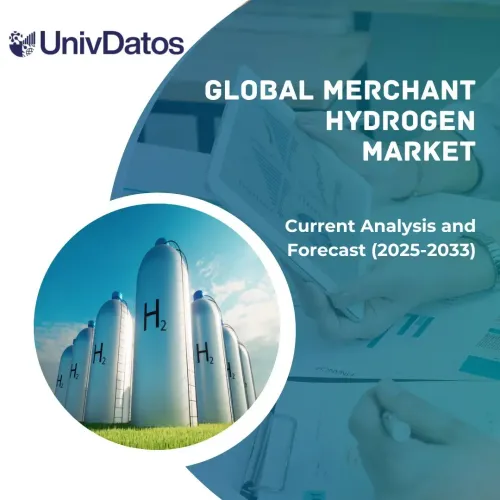- Strona główna
- O nas
- Branża
- Usługi
- Czytanie
- Kontakt
Rynek zielonego wodoru na Bliskim Wschodzie i w Afryce: aktualna analiza i prognoza (2024-2032)
Nacisk na elektrolizer (elektrolizer z membraną wymiany protonów, elektrolizer alkaliczny, inne); Źródło (energia słoneczna, energia wiatrowa, inne); Użytkownik końcowy (rafinacja, amoniak, inne); oraz kraje
Wielkość i prognoza rynku zielonego wodoru na Bliskim Wschodzie i w Afryce 2024-32F
Wartość rynku zielonego wodoru na Bliskim Wschodzie i w Afryce wyniosła 49,93 mln USD w 2023 r. i oczekuje się, że w prognozowanym okresie (2024-2032) będzie rósł w silnym tempie CAGR wynoszącym około 51,8%. Wynika to z rozwoju zielonego wodoru, który stał się priorytetem dla instytucji wielostronnych i prywatnych inwestorów.
Analiza rynku zielonego wodoru na Bliskim Wschodzie i w Afryce
Bliski Wschód i Afryka mają szansę stać się głównymi graczami na rozwijającym się rynku zielonego wodoru, dzięki obfitym zasobom energii odnawialnej, wsparciu rządowemu i strategicznym partnerstwom. Ogromny potencjał regionu w zakresie energii słonecznej i wiatrowej oferuje opłacalną ścieżkę produkcji zielonego wodoru poprzez elektrolizę, pozycjonując go jako kluczowe rozwiązanie do dekarbonizacji sektorów trudnych do redukcji emisji, takich jak przemysł ciężki i transport. Na przykład: w Omanie projekt HYPORT Duqm, będący współpracą między OQ i DEME Concessions, ma na celu produkcję 250-500 megawatów zielonego wodoru do 2029 r., zasilanego energią słoneczną i wiatrową. Egipt również staje się centrum, a Strefa Ekonomiczna Kanału Sueskiego przyciąga znaczne inwestycje w projekty związane z zielonym wodorem. Na przykład, Scatec ASA, Fertiglobe i Sovereign Fund of Egypt nawiązały współpracę w celu rozwoju instalacji zielonego wodoru o mocy 100 megawatów w Ain Sokhna.
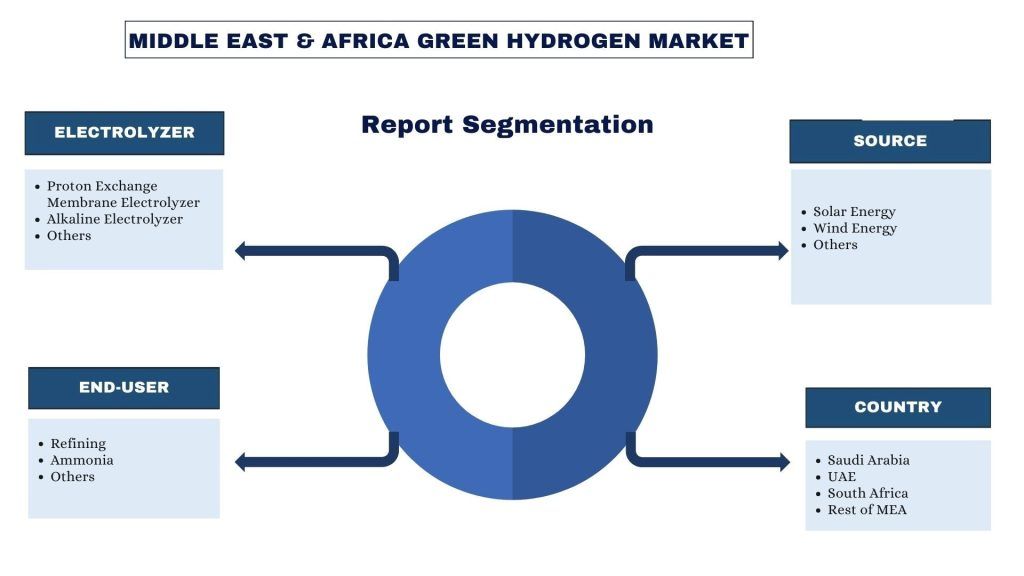
Trendy na rynku zielonego wodoru na Bliskim Wschodzie i w Afryce
Rozwój infrastruktury wodorowej na Bliskim Wschodzie i w Afryce.
Kilka krajów w regionie Bliskiego Wschodu i Afryki jest bogatych w zasoby energii odnawialnej i strategicznie usytuowanych, aby stać się kluczowymi graczami na globalnym rynku zielonego wodoru. Na przykład Arabia Saudyjska, dzięki obfitym zasobom energii słonecznej, ogłosiła plany budowy zakładu zielonego wodoru o wartości 5 miliardów dolarów w Neom, w ramach szerszej strategii Vision 2030 mającej na celu dywersyfikację gospodarki i zmniejszenie zależności od eksportu ropy naftowej. Podobnie Maroko, z dużym potencjałem w zakresie energii słonecznej i wiatrowej, uruchomiło konsorcjum Green Hydrogen w celu zbadania możliwości produkcji i eksportu zielonego wodoru. W kraju znajduje się również kompleks solarny Noor Ouarzazate, jedna z największych na świecie skoncentrowanych elektrowni słonecznych, która potencjalnie mogłaby zostać wykorzystana do zasilania produkcji zielonego wodoru w przyszłości.
Możliwości na rynku zielonego wodoru na Bliskim Wschodzie i w Afryce
Ogromny potencjał w zakresie wytwarzania energii odnawialnej:
Kraje w regionie, takie jak Arabia Saudyjska, Zjednoczone Emiraty Arabskie, Maroko i RPA, mają obfite zasoby energii słonecznej i wiatrowej, które idealnie nadają się do produkcji zielonego wodoru w procesie elektrolizy. Wykorzystując te zasoby naturalne, kraje te mogą umocnić swoją pozycję jako kluczowi gracze na globalnym rynku zielonego wodoru i zmniejszyć swoją zależność od paliw kopalnych. Na przykład: Zjednoczone Emiraty Arabskie uruchomiły strategię Dubai Clean Energy Strategy 2050, która obejmuje produkcję zielonego wodoru jako kluczowy filar w osiągnięciu celów zrównoważonego rozwoju.
Ponadto rozwój projektów zielonego wodoru na Bliskim Wschodzie i w Afryce stanowi szansę na wzrost gospodarczy i dywersyfikację. Inwestując w infrastrukturę zielonego wodoru, kraje w regionie mogą tworzyć nowe miejsca pracy, przyciągać inwestycje zagraniczne i wspierać innowacje w sektorze czystej energii. Może to pomóc w pobudzeniu rozwoju gospodarczego i zmniejszeniu zależności od tradycyjnego przemysłu naftowego i gazowego.
Oczekuje się, że Arabia Saudyjska będzie rosła w znacznym tempie CAGR w okresie prognozy
Arabia Saudyjska stała się kluczowym graczem na rynku zielonego wodoru na Bliskim Wschodzie i w Afryce, wykorzystując swoje obfite zasoby odnawialne i wykorzystując swoją strategiczną pozycję jako globalna potęga energetyczna. Królestwo aktywnie realizuje inicjatywy mające na celu rozwój solidnego ekosystemu zielonego wodoru, wnosząc znaczący wkład w regionalne i globalne wysiłki na rzecz dekarbonizacji i zrównoważonej transformacji energetycznej. Na przykład: Saudyjski Fundusz Inwestycji Publicznych (SAPIF) zamierza inwestować w kilka projektów energetycznych na całym świecie, w tym we wspólne przedsięwzięcie z Power i Air Products w celu budowy zakładu produkcji amoniaku na bazie zielonego wodoru o wartości 5 miliardów dolarów w NEOM w Arabii Saudyjskiej. Zakład będzie miał moc 1,2 GW i będzie produkował 650 ton zielonego wodoru dziennie.
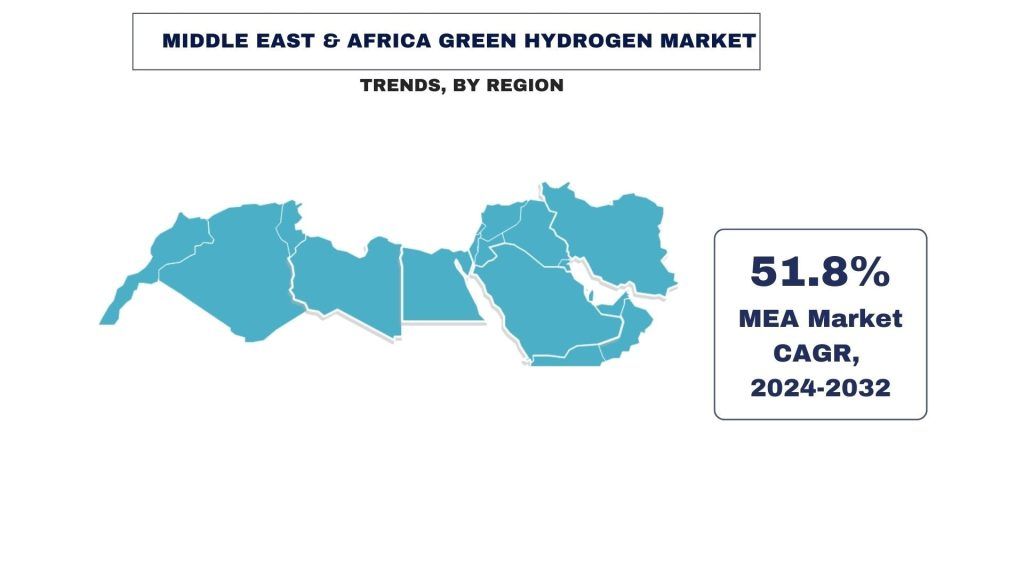
Przegląd branży zielonego wodoru na Bliskim Wschodzie i w Afryce
Rynek zielonego wodoru jest konkurencyjny i rozdrobniony, z obecnością kilku graczy rynkowych z Bliskiego Wschodu i Afryki oraz międzynarodowych. Kluczowi gracze przyjmują różne strategie rozwoju, aby wzmocnić swoją obecność na rynku, takie jak partnerstwa, umowy, współpraca, wprowadzanie na rynek nowych produktów, ekspansje geograficzne oraz fuzje i przejęcia. Niektórzy z głównych graczy działających na rynku to NEOM Helios, Oman Acme Group, Air Product & Chemical Inc, Cummins Inc, Engie SA, L’Air Liquide SA, Linde Plc, Nel ASA, Siemens Energy AG i Toshiba Energy Systems and Solutions.
Wiadomości z rynku zielonego wodoru na Bliskim Wschodzie i w Afryce
- W Omanie projekt HYPORT Duqm, będący współpracą między OQ i DEME Concessions, ma na celu produkcję 250-500 megawatów zielonego wodoru do 2029 r., zasilanego energią słoneczną i wiatrową.
- W 2024 r. TAQA Morocco, należąca do Abu Dhabi National Energy Company, ogłosiła plany zainwestowania 27,2 miliardów dolarów w projekt zielonego wodoru w regionie Dakhla-Oued El-Dahab w Maroku, aby przyspieszyć transformację energetyczną w tym północnoafrykańskim kraju.
Zakres raportu dotyczącego rynku zielonego wodoru na Bliskim Wschodzie i w Afryce
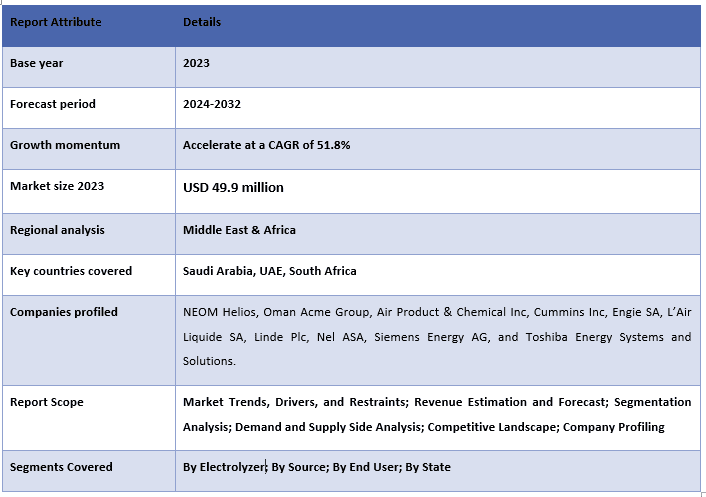
Powody, dla których warto kupić ten raport:
- Badanie obejmuje analizę wielkości rynku i prognoz, zweryfikowaną przez uwierzytelnionych kluczowych ekspertów branżowych.
- Raport przedstawia szybki przegląd ogólnej kondycji branży na pierwszy rzut oka.
- Raport obejmuje dogłębną analizę wybitnych konkurentów z branży, z głównym naciskiem na kluczowe dane finansowe przedsiębiorstw, portfele produktów, strategie ekspansji i najnowsze wydarzenia.
- Szczegółowe badanie czynników napędzających, ograniczeń, kluczowych trendów i możliwości występujących w branży.
- Badanie kompleksowo obejmuje rynek w różnych segmentach.
- Dogłębna regionalna analiza branży.
Opcje dostosowania:
Rynek zielonego wodoru na Bliskim Wschodzie i w Afryce można dodatkowo dostosować do wymagań lub dowolnego innego segmentu rynku. Poza tym UMI rozumie, że możesz mieć własne potrzeby biznesowe, dlatego skontaktuj się z nami, aby otrzymać raport, który w pełni odpowiada Twoim wymaganiom.
Spis treści
Metodologia badań dla analizy rynku zielonego wodoru na Bliskim Wschodzie i w Afryce (2024-2032)
Analiza historycznego rynku, szacowanie obecnego rynku i prognozowanie przyszłego rynku zielonego wodoru na Bliskim Wschodzie i w Afryce to trzy główne kroki podjęte w celu stworzenia i analizy stopnia wykorzystania zielonego wodoru w głównych krajach Bliskiego Wschodu i Afryki. Przeprowadzono wyczerpujące badania wtórne w celu zebrania danych historycznych dotyczących rynku i oszacowania obecnej wielkości rynku. Po drugie, aby zweryfikować te spostrzeżenia, wzięto pod uwagę liczne ustalenia i założenia. Ponadto przeprowadzono również wyczerpujące wywiady pierwotne z ekspertami branżowymi w całym łańcuchu wartości rynku zielonego wodoru na Bliskim Wschodzie i w Afryce. Po założeniu i walidacji danych rynkowych poprzez wywiady pierwotne zastosowaliśmy podejście odgórne/oddolne do prognozowania całkowitej wielkości rynku. Następnie przyjęto metody podziału rynku i triangulacji danych, aby oszacować i przeanalizować wielkość rynku segmentów i podsegmentów, których dotyczy branża. Szczegółowa metodologia została wyjaśniona poniżej:
Analiza historycznej wielkości rynku
Krok 1: Dogłębne badanie źródeł wtórnych:
Przeprowadzono szczegółowe badanie wtórne w celu uzyskania historycznej wielkości rynku zielonego wodoru za pośrednictwem wewnętrznych źródeł firmy, takich jak raporty roczne i sprawozdania finansowe, prezentacje wyników, komunikaty prasowe itp., oraz źródeł zewnętrznych, w tym czasopisma, wiadomości i artykuły, publikacje rządowe, publikacje konkurencji, raporty sektorowe, bazy danych stron trzecich i inne wiarygodne publikacje.
Krok 2: Segmentacja rynku:
Po uzyskaniu historycznej wielkości rynku zielonego wodoru przeprowadziliśmy szczegółową analizę wtórną w celu zebrania historycznych danych rynkowych i udziałów dla różnych segmentów i podsegmentów dla głównych regionów. Główne segmenty zawarte w raporcie to elektrolizer, źródło i użytkownik końcowy. Ponadto przeprowadzono analizy na poziomie krajowym w celu oceny ogólnego stopnia wykorzystania modeli testowych w danym regionie.
Krok 3: Analiza czynnikowa:
Po uzyskaniu historycznej wielkości rynku różnych segmentów i podsegmentów przeprowadziliśmy szczegółową analizę czynnikową w celu oszacowania obecnej wielkości rynku zielonego wodoru. Ponadto przeprowadziliśmy analizę czynnikową przy użyciu zmiennych zależnych i niezależnych, takich jak elektrolizer, źródło i użytkownik końcowy rynku zielonego wodoru. Przeprowadzono dokładną analizę scenariuszy popytu i podaży, biorąc pod uwagę najważniejsze partnerstwa, fuzje i przejęcia, ekspansję biznesową i wprowadzenie produktów na rynek w sektorze zielonego wodoru w całym regionie.
Szacowanie i prognozowanie obecnej wielkości rynku
Określanie obecnej wielkości rynku: W oparciu o praktyczne spostrzeżenia z powyższych 3 kroków doszliśmy do obecnej wielkości rynku, kluczowych graczy na rynku zielonego wodoru na Bliskim Wschodzie i w Afryce oraz udziałów rynkowych segmentów. Wszystkie wymagane udziały procentowe i podziały rynku zostały określone przy użyciu wspomnianego powyżej podejścia wtórnego i zostały zweryfikowane poprzez wywiady pierwotne.
Szacowanie i prognozowanie: Do celów szacowania i prognozowania rynku przypisano wagi różnym czynnikom, w tym czynnikom napędzającym i trendom, ograniczeniom i możliwościom dostępnym dla zainteresowanych stron. Po przeanalizowaniu tych czynników zastosowano odpowiednie techniki prognozowania, tj. podejście odgórne/oddolne, aby dojść do prognozy rynkowej na rok 2032 dla różnych segmentów i podsegmentów na głównych rynkach Bliskiego Wschodu i Afryki. Metodologia badań przyjęta do oszacowania wielkości rynku obejmuje:
- Wielkość rynku branży pod względem przychodów (USD) i stopień wykorzystania rynku zielonego wodoru na głównych rynkach krajowych
- Wszystkie udziały procentowe, podziały i rozbicia segmentów rynku i podsegmentów
- Kluczowi gracze na rynku zielonego wodoru na Bliskim Wschodzie i w Afryce pod względem oferowanych produktów. Ponadto strategie wzrostu przyjęte przez tych graczy, aby konkurować na szybko rozwijającym się rynku
Walidacja wielkości i udziału w rynku
Badania pierwotne: Przeprowadzono dogłębne wywiady z kluczowymi liderami opinii (KOL), w tym z kadrą kierowniczą wyższego szczebla (CXO/wiceprezesi, szef sprzedaży, szef marketingu, szef operacyjny, szef regionalny, szef krajowy itp.) w głównych regionach. Wyniki badań pierwotnych zostały następnie podsumowane i przeprowadzono analizę statystyczną w celu udowodnienia postawionej hipotezy. Dane wejściowe z badań pierwotnych zostały połączone z danymi wtórnymi, przekształcając w ten sposób informacje w praktyczne spostrzeżenia.
Podział uczestników pierwotnych w różnych regionach
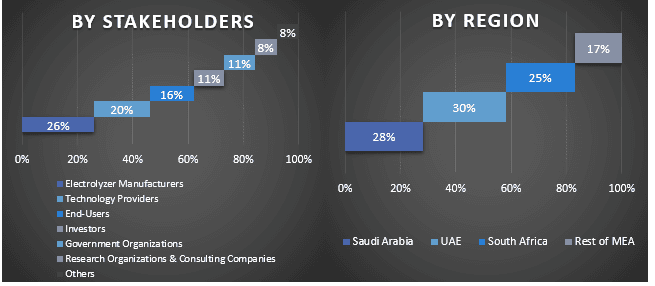
Inżynieria rynku
Zastosowano technikę triangulacji danych, aby ukończyć ogólne szacowanie rynku i dojść do precyzyjnych danych statystycznych dla każdego segmentu i podsegmentu rynku zielonego wodoru na Bliskim Wschodzie i w Afryce. Dane zostały podzielone na kilka segmentów i podsegmentów po przestudiowaniu różnych parametrów i trendów w obszarach elektrolizera, źródła i użytkownika końcowego na rynku zielonego wodoru na Bliskim Wschodzie i w Afryce.
Główny cel badania rynku zielonego wodoru na Bliskim Wschodzie i w Afryce
W badaniu określono obecne i przyszłe trendy rynkowe na rynku zielonego wodoru na Bliskim Wschodzie i w Afryce. Inwestorzy mogą uzyskać strategiczne spostrzeżenia, na których mogą opierać swoje decyzje inwestycyjne, w oparciu o analizę jakościową i ilościową przeprowadzoną w badaniu. Obecne i przyszłe trendy rynkowe określiły ogólną atrakcyjność rynku na poziomie regionalnym, zapewniając uczestnikom przemysłowym platformę do wykorzystania niewykorzystanego rynku w celu skorzystania z przewagi pioniera. Inne cele ilościowe badań obejmują:
- Analiza obecnej i prognozowanej wielkości rynku zielonego wodoru pod względem wartości (USD). Ponadto analiza obecnej i prognozowanej wielkości rynku różnych segmentów i podsegmentów.
- Segmenty w badaniu obejmują obszary elektrolizera, źródła i użytkownika końcowego.
- Zdefiniowanie i analiza ram regulacyjnych dla zielonego wodoru
- Analiza łańcucha wartości związanego z obecnością różnych pośredników, wraz z analizą zachowań klientów i konkurentów branży.
- Analiza obecnej i prognozowanej wielkości rynku zielonego wodoru dla głównych krajów.
- Główne kraje regionów badanych w raporcie to Arabia Saudyjska, ZEA, Republika Południowej Afryki i pozostała część regionu MEA.
- Profile firm z rynku zielonego wodoru oraz strategie wzrostu przyjęte przez uczestników rynku, aby utrzymać się na szybko rozwijającym się rynku.
- Dogłębna analiza branży na poziomie regionalnym
Najczęściej zadawane pytania FAQ
P1: Jaka jest obecna wielkość rynku i potencjał wzrostu rynku zielonego wodoru na Bliskim Wschodzie i w Afryce?
P2: Jakie czynniki napędzają wzrost rynku zielonego wodoru?
P3: Który segment ma największy udział w rynku zielonego wodoru pod względem elektrolizera?
P4: Jakie są wschodzące technologie i trendy na rynku zielonego wodoru?
P5: Który kraj zdominuje rynek zielonego wodoru na Bliskim Wschodzie i w Afryce?
Powiązane Raporty
Klienci, którzy kupili ten przedmiot, kupili również

